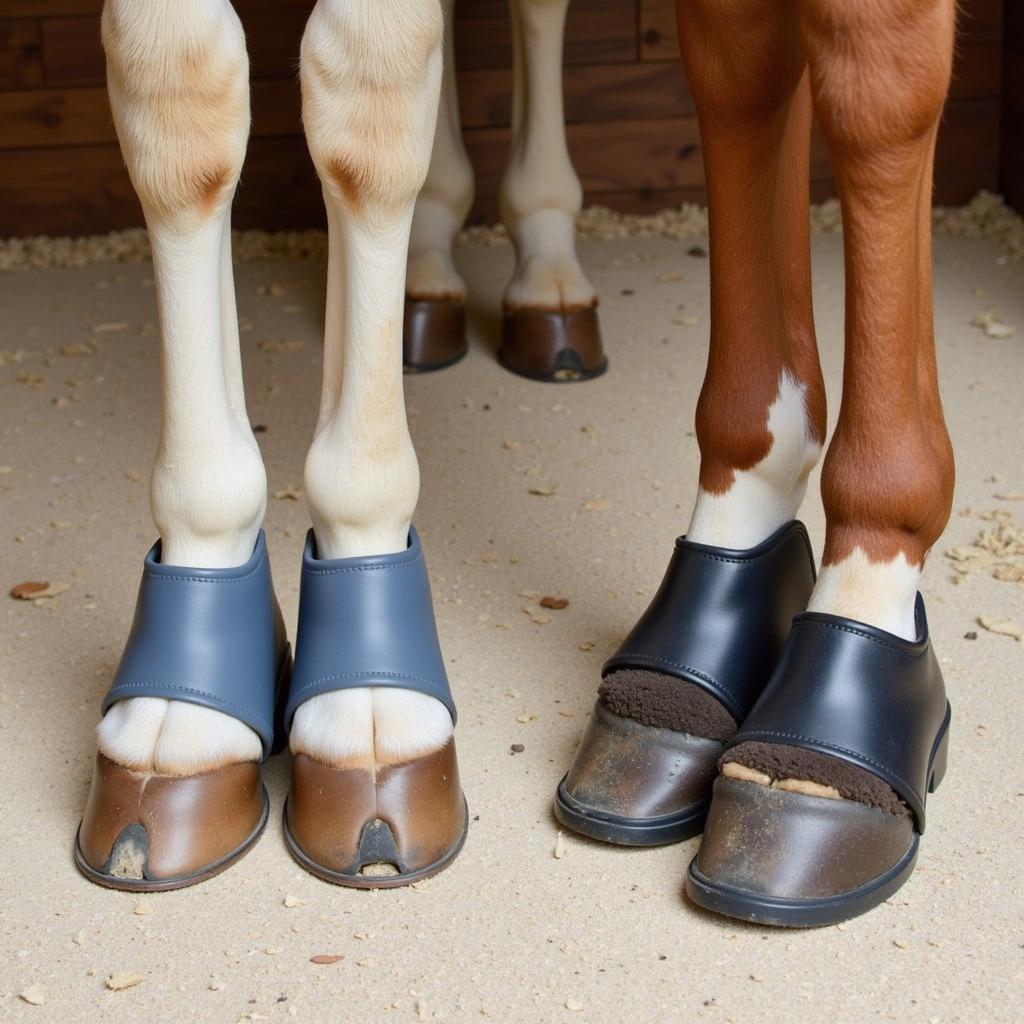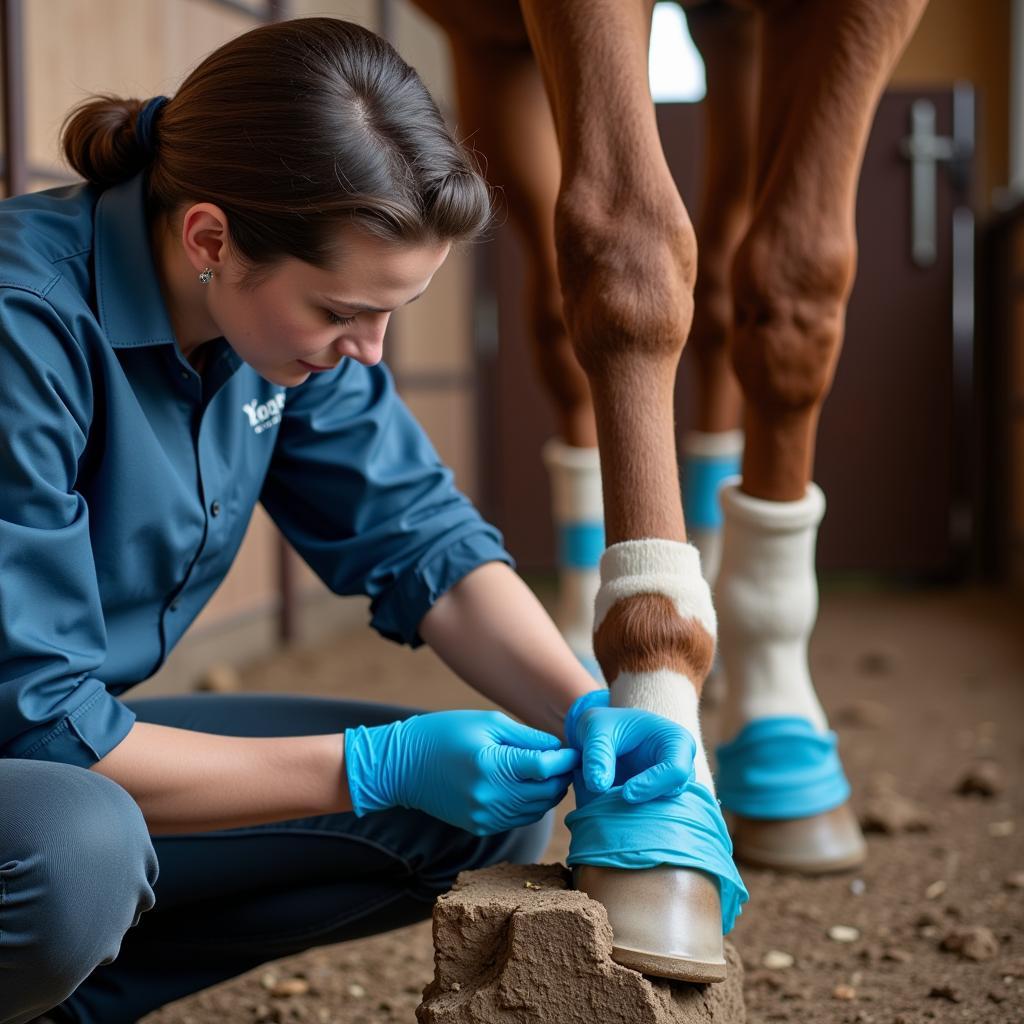Horses with laminitis require special care, and their hooves need extra support. Clogs For Horses With Laminitis play a crucial role in providing comfort, stability, and promoting healing during this challenging time. Whether you’re new to equine hoof care or seeking a deeper understanding of clogs and their benefits, this comprehensive guide will provide valuable insights.
What are Clogs for Horses with Laminitis?
 Horses with Laminitis Wearing Clogs
Horses with Laminitis Wearing Clogs
Clogs are temporary, supportive footwear designed to alleviate pain and encourage healing in horses suffering from laminitis. Unlike traditional horseshoes, clogs completely encapsulate the hoof, offering 360-degree protection and support. They are typically made from lightweight yet durable materials such as rubber or polyurethane, providing cushioning and shock absorption.
Why are Clogs Used for Laminitis?
Laminitis, also known as founder, is a painful inflammatory condition affecting the laminae, which are sensitive tissues that bond the hoof wall to the pedal bone within the hoof. When inflammation occurs, these laminae can become damaged, leading to instability and pain.
Clogs play a vital role in laminitis management by:
- Reducing pressure on the laminae: The cushioned footbed of clogs helps distribute the horse’s weight more evenly, alleviating pressure on the inflamed laminae.
- Providing stability to the hoof capsule: By encasing the hoof, clogs offer stability and prevent further rotation or sinking of the pedal bone, common complications in severe laminitis cases.
- Promoting blood circulation: The gentle pressure applied by clogs can enhance blood circulation to the hoof, aiding in the healing process.
Types of Clogs Available
Several types of clogs cater to the varying needs of horses with laminitis:
- Full-Support Clogs: Ideal for acute laminitis or severe cases, these clogs offer maximum support and immobilization to the hoof.
- Open-Toe Clogs: These clogs provide support while allowing for some hoof expansion and contraction, making them suitable for horses in the later stages of recovery.
- Custom-Molded Clogs: For horses with unique hoof conformations or those requiring specific support, custom-molded clogs offer a personalized fit.
When to Use Clogs for Horses with Laminitis
Early intervention is key in managing laminitis. Consult with your veterinarian as soon as you suspect your horse might be suffering from this condition. They can accurately diagnose the severity and recommend appropriate treatment, which may include the use of clogs.
How to Apply and Care for Clogs
 Applying Clogs to Horse with Laminitis
Applying Clogs to Horse with Laminitis
Proper application and care are essential for clogs to be effective. Your veterinarian or a qualified farrier will:
- Clean and trim the hoof thoroughly before applying the clog.
- Ensure a snug fit to prevent rubbing or discomfort.
- Advise on a regular cleaning and inspection schedule to maintain hygiene and monitor the hoof’s condition.
Tips for Choosing the Right Clogs
- Consult with your veterinarian or farrier for personalized recommendations based on your horse’s individual needs.
- Choose clogs made from durable, easy-to-clean materials.
- Ensure the clogs fit properly and provide adequate support.
“Selecting the correct type of clog for a horse with laminitis is paramount,” says Dr. Emily Carter, DVM, specializing in equine podiatry. “Factors such as the severity of the condition, the horse’s weight, and the intended use all play a crucial role in determining the most appropriate clog.”
Conclusion
Clogs for horses with laminitis are invaluable tools in providing support, comfort, and aiding in the healing process. By understanding the different types of clogs available, their benefits, and proper application techniques, horse owners can make informed decisions regarding their horse’s hoof care. Always consult with your veterinarian for accurate diagnosis, treatment, and ongoing management of laminitis.
FAQs about Clogs for Horses with Laminitis
1. How long do horses need to wear clogs for laminitis?
The duration of clog use varies depending on the severity of the laminitis and the horse’s individual recovery progress. It can range from a few weeks to several months.
2. Can horses with clogs live a normal life?
While clogs provide support and comfort, they may restrict movement to some extent. Horses with clogs may need to be on a restricted exercise program as advised by their veterinarian.
3. Are there alternatives to clogs for laminitis?
Alternative treatment options for laminitis may include therapeutic shoeing, pain management medications, and dietary modifications.
4. How can I prevent my horse from developing laminitis?
Preventing laminitis involves careful management of your horse’s diet, weight, and exercise routine. Regular hoof care and prompt attention to any signs of lameness are also crucial.
5. What should I do if I suspect my horse has laminitis?
If you suspect laminitis, contact your veterinarian immediately. Early intervention is essential for the best possible outcome.
Need Help?
For personalized advice on clogs for horses with laminitis, contact us! Our dedicated team at Justus Horses USA is here to assist you.
Phone: 0772127271
Email: [email protected]
Address: QGM2+WX2, Vị Trung, Vị Thuỷ, Hậu Giang, Việt Nam
We offer 24/7 customer support to answer your questions and provide guidance on choosing the right products for your equine companions.